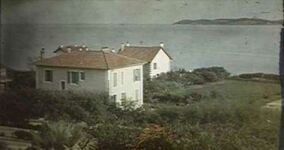
Gabriel Lippmann conceived a two-step method to record and reproduce colours, variously known as direct photochromes,[1] interference photochromes,[1] Lippmann photochromes,[1] Photography in natural colours by direct exposure in the camera[1] or the Lippmann process of colour photography.[2] Lippmann won the Nobel Prize in Physics for this work in 1908.
A Lippmann plate is a clear glass plate (having no anti-halation backing), coated with an almost transparent (very low silver halide content) emulsion of extremely fine grains, typically 0.01 to 0.04 micrometres in diameter.[3] Consequently, Lippmann plates have an extremely high resolving power[4] exceeding 400 lines/mm.
- ^ a b c d Eder, J.M. (1945) [1932]. History of Photography, 4th. edition [Geschichte der Photographie]. New York: Dover Publications. pp. 668, 670, 671, 672. ISBN 0-486-23586-6.
- ^ US 6556992
- ^ R.W.G. Hunt, The Reproduction of Colour, 6th ed, p6
- ^ "Emulsion Definition". www.tpub.com. Archived from the original on 24 July 2010. Retrieved 12 January 2022.